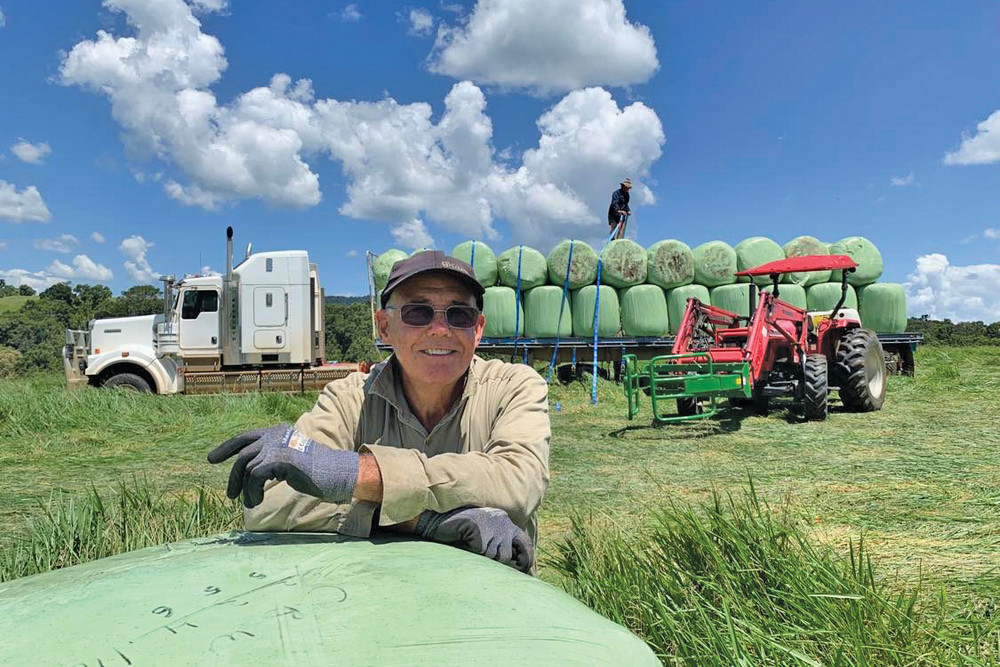On The Land
18 March, 2022
Silage value adds Tableland country
LOOKING for a way to value add to his 45-ha farm on the southern Tablelands, Paul Bradshaw has begun producing silage hay so delicious it has literally brought the tree climbing kangaroos down out of the trees to feed.

“When I did my first cut last year, we opened a bale out in the paddock to have a look at it and the cattle went crazy. Already on good feed, they burrowed into the bale, eating right into the centre, they were pawing at it and getting down, trying to roll in it,” he said.
“Then in broad daylight, in the middle of all the fracas, a tree kangaroo climbed down out of a nearby tree and came over to eat from the 500kg bale of brachiari and creeping vigna silage! They say the proof is in the pudding, but I certainly did not expect that reaction!”
Mr Bradshaw said after they purchased the rundown Millaa Millaa farm, that has now been the family’s home for 15 years, he fertilised it and locked it up for three years in a row, mulching the grass back down into the soil, and building up the soil quality.
“For the last few years, I have been applying Fodder Booster, a prescription silage blend fertiliser at 300kg/hectare. When ready for harvest, the dark green, high protein pasture was ensiled in the afternoon at its highest sugar content level,” he said.
“I know I am producing a good product, but I have learned that being a good farmer and a successful business person are two completely different things. I thought that if I had a good product at a fair price it would sell, but it’s not that simple.”
Mr Bradshaw said in good seasons, there was little demand for product locally and the reduced sales made it hard to maintain fair prices during dry times.
“I don’t want to be one of those businesses that cash in on other people’s hardship during drought, but I also need to survive in the meantime,” he said.
“So the western market has been a good option this year. I just loaded a semi-trailer of silage for a Charters Towers client needing feed for weaners. They are looking down the barrel of another dry year out west and apparently the cattle are loving the hay.”
Mr Bradshaw initially planned to grow silage for his own use. Observing that beef cattle walk a lot more than dairy cows causing damage to paddocks in the extreme wet Millaa Millaa conditions, he thought he would buy a “dry block” to run cattle west of Ravenshoe and take good quality feed to them.
“Millaa has the rainfall and soils needed to grow good quality pasture and the drier country is better suited to beef cattle. I believed the dung from those molasses and silage fed cattle would actually improve the soil quality there over time,” he said.
The second property didn’t eventuate, but Mr Bradshaw’s love affair with silage continued.
“Silage is a bankable product. It will keep for up to two years just laying out in the paddock and for up to fi ve years when shredded. It also ensures you can hang on to your best breeders even during a bad dry season,” he said.
The grandson of a drover, Mr Bradshaw had wanted to own a farm on the Atherton Tablelands for as long as he could remember. Raised in Townsville, it was the mining industry however that occupied the first couple of decades of his working life.
Proud of his family’s multi-generational association with cattle, he wound up working underground, for 13 years in the coal at Central Queensland’s Oakey Creek mine after spending nine years in underground hard rock mining around Charters Towers.
Even though he planned to cease his mining job earlier, it took until his children had gone to university in 2006 for Mr Bradshaw to make the move back to the land.
They bought the Millaa farm in 2006 and after a lot of hard work and money to improve pastures, it was up to scratch. But when Mr Bradshaw realised that cattle alone were not going to provide enough income to cover all the costs, he starting producing 70kg lick blocks from a mixture he had perfected over a long period of time.
“The people who used them, loved them, but Tableland customers were telling me they were too big for them to handle and customers from out west reckoned they were too small, so it was back to the drawing board,” Mr Bradshaw said.
“It was about this time we started doing quite a bit of international travel to places like the Netherlands and Switzerland. Although colder there, I noticed there were a lot of similarities. It was lush and green everywhere and the farms were around the same size as those on the Tablelands.
“I saw that all the farmers there were cutting silage, they were doing it everywhere, on school grounds, on the sides of roads and footpaths. I thought of the good, level 10- ha paddock I had on my farm at home and decided silage was worth a try.”



